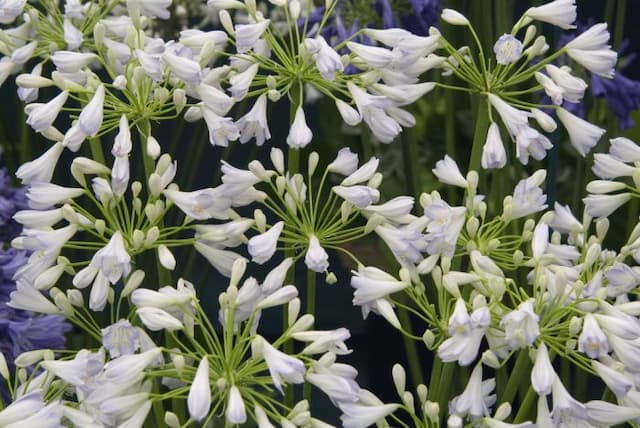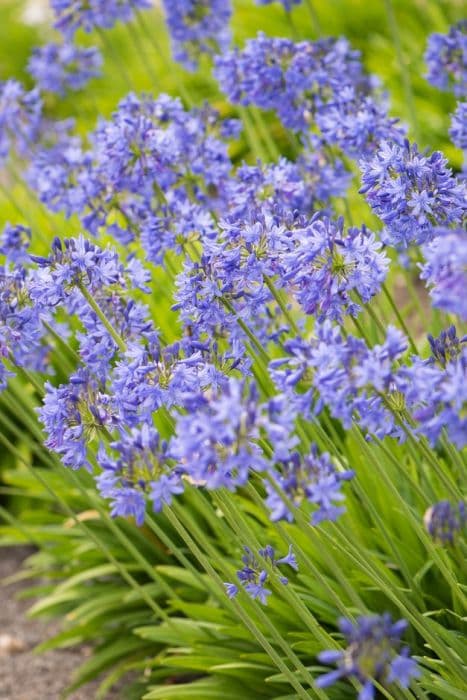African Lily Agapanthus Twister = 'Ambic001' (PBR)
![African lily [Twister]](/_next/image?url=https%3A%2F%2Fplants-admin.emdemapps.com%2Fimages%2Fplants%2F%2Fimages%2F604b651c91bb8.png&w=3840&q=75)
ABOUT
The Agapanthus Twister showcases a striking display with its unique flowers and lush foliage. The plant is notable for its bicolored blooms that dance atop tall, sturdy stems. The flowers are a delightful mix of blue and white, with each trumpet-shaped bloom showing off a creamy-white interior that graduates to a vibrant blue at the petal edges. This enchanting two-tone effect gives the impression of a swirling pattern, hence the name 'Twister'. Flowering in clusters, also known as umbels, the blossoms form rounded heads that create a spectacular sight when they adorn the garden in the blooming season. Below the impressive floral display, the plant features dense clumps of strap-like leaves. These leaves are glossy and arch gracefully, adding to the overall lushness of the Agapanthus Twister. The captivating contrast between the cool blue and white of the flowers and the rich green of the foliage makes the Agapanthus Twister an eye-catching addition to any landscape. It's a favorite among gardeners not just for its aesthetic appeal but also for its ability to add a touch of elegance to the surroundings. Despite the omission of specific dimensions, the plant's visual impact is not diminished. The descriptions of its coloration, flower shape, and leaf texture provide a vivid portrayal of its appearance, ensuring a comprehensive understanding of its ornamental qualities.
About this plant
 Names
NamesFamily
Amaryllidaceae.
Synonyms
African Lily, Lily Of The Nile, Twister African Lily, Twister Lily Of The Nile.
Common names
Agapanthus 'Ambic001' (PBR), Agapanthus praecox 'Twister'.
 Toxicity
ToxicityTo humans
The common name for Agapanthus Twister 'Ambic001' (PBR) is Lily of the Nile. This plant is considered mildly toxic to humans if ingested. The toxicity can cause gastrointestinal symptoms such as nausea, vomiting, and diarrhea. In some cases, the sap of the plant may cause skin irritation or allergic reactions upon contact. It is advisable to handle plants with care and to keep them out of reach of children who might accidentally ingest plant parts.
To pets
Lily of the Nile is also known to be toxic to pets, including dogs and cats. If a pet ingests parts of this plant, it can lead to symptoms similar to those seen in humans, such as vomiting, diarrhea, and nausea. Additionally, the plant's sap can cause irritation to the mouth and esophagus. It is important to prevent pets from chewing on or ingesting this plant to avoid these potential health issues.
 Characteristics
CharacteristicsLife cycle
Perennials
Foliage type
Evergreen
Color of leaves
Green
Flower color
Mixed
Height
2 feet [60 cm]
Spread
2 feet [60 cm]
Plant type
Bulb
Hardiness zones
Varies
Native area
South Africa
Benefits
 General Benefits
General Benefits- Aesthetic Appeal: Produces striking bicolored blue and white flowers that add visual interest to any garden.
- Drought Tolerance: Once established, it requires minimal watering, making it a water-efficient choice.
- Low Maintenance: Requires little care beyond occasional feeding and dividing, suitable for busy gardeners.
- Attracts Pollinators: Flowers attract bees and butterflies, supporting local ecosystems.
- Long Blooming Period: Offers a long-lasting display of flowers from early to late summer.
- Versatility in Landscaping: Can be used in borders, containers, or as a focal point in garden designs.
- Perennial Growth: Returns year after year, providing long-term value for the investment.
- Deer Resistant: Generally not palatable to deer, which can help protect other plants in the garden.
 Medical Properties
Medical PropertiesThis plant is not used for medical purposes.
 Air-purifying Qualities
Air-purifying QualitiesThis plant is not specifically known for air purifying qualities.
 Other Uses
Other Uses- Photography Prop: The striking blooms of the African Lily can serve as an excellent prop for photographers looking to add natural beauty to their portraits or landscape shots.
- Culinary Garnish: Although not typically used for consumption, the unique blue and white flowers of the African Lily can be used as an ornate garnish for special dishes at events.
- Educational Material: The distinct morphology of the African Lily can be used in educational settings to teach plant structure and pollination strategies to students.
- Artistic Inspiration: Artists might use the African Lily as a subject for paintings, drawings, or other art projects, thanks to its appealing form and color.
- Ecological Studies: The African Lily can be the subject of ecological studies examining its interactions with pollinators or its role in garden ecosystems.
- Stormwater Management: The African Lily, when planted en masse, could help in managing stormwater runoff in garden landscapes because of its robust root system.
- Themed Event Decoration: For events with a blue and white theme, such as weddings or parties, the African Lily can be used as part of the floral arrangements.
- Dye Production: The petals of the African Lily, though not commonly used, have the potential for creating natural dyes for fabrics or crafts.
- Botanical Illustration: The aesthetic appeal of the African Lily makes it a great candidate for botanical illustration, particularly for educational books or botanical prints.
- Performance Art: The African Lily could be incorporated into performance art, with its flowers symbolizing various themes or playing a role in the narrative of the piece.
Interesting Facts
 Feng Shui
Feng ShuiThe African Lily, commonly known as Agapanthus, is not traditionally used in Feng Shui practice.
 Zodiac Sign Compitability
Zodiac Sign CompitabilityThe African Lily is not used in astrology practice.
 Plant Symbolism
Plant Symbolism- Love Letters: The name Agapanthus comes from the Greek words 'agape' meaning love, and 'anthos' meaning flower. It is often considered to symbolize love letters or messages.
- Enduring Love: Because of the plant's hardiness and ability to withstand tough conditions, it symbolizes enduring or long-lasting love.
- Beauty: With its striking blue and white flowers, the Agapanthus is often associated with beauty and admiration.
- Fertility: In some cultures, the lush growth and rounded clusters of the plant's blooms are symbolic of fertility and abundance.
- Freedom: Some interpretations hold that Agapanthus represents freedom due to its free-flowing nature and tendency to spread out in a garden.
- Protection: In some South African cultures, the Agapanthus is believed to ward off thunderstorms, symbolizing protection.
 Water
WaterThe Lily of the Nile, or Agapanthus 'Twister', should be watered deeply to ensure the soil is moist but not waterlogged. During the growing season in spring and summer, water once every week with about 1-2 gallons per plant, depending on the weather conditions. In the winter months, reduce watering to every few weeks, allowing the soil to dry out slightly between waterings. Ensure proper drainage to prevent root rot, and if grown in a container, check the potting soil more frequently as it tends to dry out faster.
 Light
LightLily of the Nile flourishes best in full sun to partial shade. Plant Agapanthus 'Twister' in a spot that receives at least 6 hours of direct sunlight a day to encourage abundant flowering. However, in extremely hot climates, some afternoon shade is beneficial to protect the plant from intense heat.
 Temperature
TemperatureThe Lily of the Nile prefers temperate climates and thrives best in temperatures between 50 and 80 degrees Fahrenheit. It can tolerate temperatures as low as 20 degrees Fahrenheit but should be protected from frost. Provide a sheltered position or bring containers indoors if temperatures drop near freezing.
 Pruning
PruningPrune Lily of the Nile after flowering to remove spent flower stalks and encourage a tidy appearance. Cut back to the base of the stalk. Additionally, remove any damaged or dead foliage as needed. The best time for pruning is late fall or early spring before new growth begins.
 Cleaning
CleaningAs needed
 Soil
SoilThe Agapanthus, commonly known as Lily of the Nile, thrives in a soil mix that is well-draining and fertile. For optimal growth, a mixture of two parts loam to one part sand or perlite is recommended, which ensures adequate drainage while retaining nutrients. The ideal soil pH for the Lily of the Nile is slightly acidic to neutral, ranging from 6.0 to 7.0.
 Repotting
RepottingLily of the Nile, or Agapanthus, should be repotted every 2-3 years to refresh the soil and allow room for growth. Best practice is to repot in the spring before new growth begins. When repotting, it's important to choose a slightly larger pot to accommodate the expanding root system.
 Humidity & Misting
Humidity & MistingAgapanthus, or Lily of the Nile, prefers moderate humidity levels. While it can tolerate some dry air, achieving an environment with around 40-60% humidity is ideal for this plant. Avoid placing it in excessively dry or overly humid conditions.
 Suitable locations
Suitable locationsIndoor
Place Lily of the Nile in bright indirect light, water when soil dries.
Outdoor
Full sun to part shade, fertile well-draining soil, moderate watering.
Hardiness zone
8-11 USDA
 Life cycle
Life cycleThe life cycle of the Agapanthus 'Twister', also known as the African Lily, begins with seed germination or vegetative reproduction through division. Seedlings or divided rhizomes develop into juvenile plants, establishing a strong root system and foliage. As the plant matures, it develops long, strappy leaves and begins the vegetative growth stage where it gains size and strength. Following this period of vegetative growth, the African Lily enters the flowering stage during summer where it produces tall flower stalks with distinctive blue and white bicolour blooms. After pollination, if it occurs, the flowers will develop seed pods that mature and eventually release seeds, completing the reproductive cycle. Finally, in colder climates, the African Lily may experience a dormancy stage during winter where growth slows down or ceases until favorable conditions return in spring.
 Propogation
PropogationPropogation time
Spring-Early Summer
The Agapanthus Twister is commonly propagated by division, a process which is typically carried out in the spring or early summer, just before the growing season begins. To propagate by division, the gardener should carefully lift the plant from the ground, ensuring to keep as much of the root system intact as possible. Once lifted, the clump should be separated into smaller sections, each with at least two or three shoots and a portion of the root system. These sections are then replanted at the same depth they were growing previously, spaced about 18 inches (approximately 45 centimeters) apart to allow for ample room for growth. Water the new divisions well and maintain consistent moisture as they establish themselves. This method leverages the plant's natural clumping growth habit to create new plants that will mature and bloom, often within a season or two.









